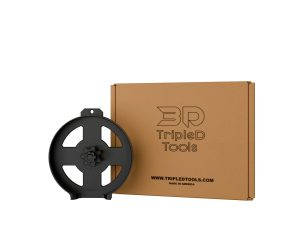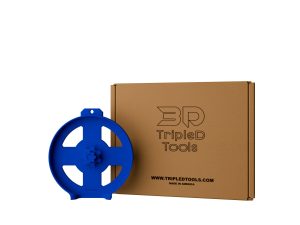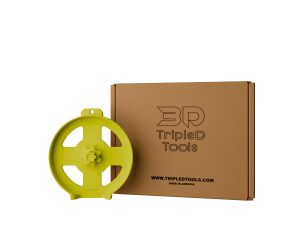May 19, 2025
Storing your circular saw blades properly is essential for both safety and maintaining the blades’ performance. A good blade can be a significant investment, so it pays to protect its sharp carbide teeth from damage. Improper storage – like tossing blades loose in a drawer or truck bed – can lead to dulling, chipping, rust, or even personal injury when handling them. As one manufacturer puts it, “Blades banging into each other or left open to elements such as dust and moisture can dull and damage your equipment”, so the ideal storage method keeps each blade separated and contained . In this article, we’ll explore expert advice from tool manufacturers and veteran woodworkers on how to store and transport circular saw blades safely. Following these tips will extend the life of your blades, ensure cleaner cuts, and keep you and your crew safe.
Loose blades = damaged blades. The carbide teeth on saw blades are hard but brittle. If blades are stored loosely so that they knock or rub against each other, those teeth can easily get chipped or dulled. In fact, Forrest Manufacturing (a well-known blade maker) warns that if blades bang together (for example, during shipping or storage), “you are likely to get chipping… In the case of saw blades, it’s the tips that tend to break off.” Just like wrapping individual dishes to prevent breakage, you should never let bare blades directly touch one another in storage . Even laying a blade unprotected on a hard metal shelf or concrete floor can chip the cutting edges – “metal on metal or metal on cement can dull the blade by chipping the top grind of the tooth”, advises one expert . Always set blades down on a softer surface (wood or plastic) or use a protective sleeve/cover to shield the teeth.
Moisture causes rust and corrosion. Even when a blade is idle, exposure to humidity can degrade it. Steel can rust surprisingly fast, ruining the precision-ground edges. A Pro Tool Reviews article notes that “moisture and humidity will degrade [a blade]. Particularly on more expensive blades, consider removing them and keeping them dry when not in use… store it in a dry area.” Doing so “increases the length of time your carbide teeth will retain their optimal edge.” In short, keep your blades dry. Avoid leaving them in damp garages or the back of a pickup truck bed in the rain. If you live in a humid climate or won’t use a blade for a while, it’s wise to store it with a desiccant (silica gel pack) or even give it a light coat of rust inhibitor (oil, silicone spray, etc.) before storage . Preventing rust means your blade stays sharper longer and won’t require re-polishing or re-sharpening as often.
Safety for you and your tools. A 7¼-inch circular saw blade might not look as sharp as a knife, but its teeth can absolutely cut you if you grab it wrong – even a “dull” blade can inflict a serious laceration . Storing blades loosely in a toolbox or drawer is asking for trouble; you (or someone else) might reach in and get sliced on the unseen teeth. Always store blades in a way that covers the teeth or at least keeps them from being a hand hazard (many blade cases and DIY holders achieve this). Also, loose blades rattling around with other tools can damage those tools or the blades. They could even cause a sparking hazard in metal toolboxes if they scrape against batteries or wiring. Lastly, never forget that a heavy saw blade is a chunk of steel – if it slides off a shelf or falls, it could cut toes or damage surfaces. The takeaway: treat your blades with the same care you’d treat a loaded blade on the saw – guard it when not in use.
Don’t drop or toss blades around. Carbide teeth are welded/brazed onto the blade’s rim, and while they handle cutting stresses, a hard drop can crack or break them off. Tool manufacturers explicitly caution users: “Store blades with care. Do not drop them.” A blade that has been dropped might have micro-fractures or warped tension, leading to poorer cuts or even safety issues (e.g. tooth coming off at high speed). Always carry and set down blades gently. If a blade does fall, inspect it carefully for any missing/chipped teeth or bends before using it – it may need professional sharpening or replacement to be safe.
What do the pros do to keep their saw blades in top shape? Here are key guidelines compiled from reputable sources (tool manufacturers, blade makers, and veteran woodworkers):
Separate Every Blade: However you store blades, the golden rule is to prevent them from touching each other (or other metal objects). Freud’s blade specialists advise either hanging each blade on its own hook or storing them individually in slots/compartments so that no two blades ever rub together . If you stack blades in a drawer or box, use dividers or padding between each one (cardboard, wood, foam, etc.). Woodworkers often save the cardboard sleeves that new blades come in – “if the manufacturer puts the blade in a good cardboard container (like Forrest does), just storing them on edge in that packaging… is convenient” . You can also make your own blade envelopes out of heavy cardboard or old magazine file folders . The important thing is that carbide teeth never bang into another carbide tooth or hard surface. This prevents the tiny, brittle teeth from chipping off.
Support the Blade – Don’t Trust the Teeth: Be mindful of how a blade sits in storage. The carbide teeth are usually a bit wider than the plate (body) of the blade. That means if you lie a blade perfectly flat on a surface, it might actually be resting on the tips of its teeth – not good! One craftsman explains that “if a blade is stored flat without any support at the arbor hole, the blade will, in fact, be resting on the teeth edges… This does not sound like a good idea because you could damage the teeth” over time . To store blades flat, support them by the center so the teeth aren’t bearing weight – for example, use a board with a dowel or a raised hub that goes through the arbor (center) hole. Better yet, store blades on their edge or hang them by the center. Hanging is a popular option: “If you hang them, use the center hole” – a simple nail or hook in the shop wall through the arbor hole keeps the blade upright and the teeth away from any surface . Just be sure the blade isn’t swinging around to hit anything. Many woodworkers screw a few hooks or nails on a wall or inside a cabinet to hang blades this way. Tip: If using pegboard hooks, put a short piece of ¼″ plywood or rubber tubing as a spacer behind the blade so it doesn’t touch the wall.
No Hard Metal-on-Metal Contact: This bears repeating – avoid storing blades against anything metal (like tossing them in a steel toolbox or stacking them on a cast iron tablesaw top). The vice president of Forrest Mfg. specifically “warns woodworkers never to rest circular saw blades on steel or cement surfaces”, because even slight contact can chip the teeth or wear off protective coatings . Instead, set blades on wood, plastic, or another blade-friendly material. For instance, if you’re temporarily putting a blade down on a workbench, lay it on a piece of plywood or an old rubber mat rather than directly on concrete or metal. Some contractors keep an old towel or carpet square in their toolbox to wrap blades for this reason.
Keep Blades Dry and Clean: As mentioned, moisture is a blade’s enemy. Store blades in a climate-controlled area if possible, or include desiccants if in a case. If a blade does get wet or used in a damp environment, dry it off and give it a light oil wipe before storing to prevent rust. Also, clean resin or pitch off your blades periodically; built-up gunk can hold moisture against the metal and promote corrosion (not to mention it causes poor cutting performance). A clean, dry blade stored in a dry place will last much longer between sharpenings . Some woodworkers even spray their stored blades with a little WD-40 or wrap them in rust-inhibitor paper if they won’t be used for a while .
Orientations – Flat vs. Hanging: Woodworkers sometimes debate whether it’s best to store blades flat (horizontally) or upright (vertically). The truth is either can work fine as long as the blade is supported and protected. The late Charles M. (a representative from Freud) once noted that “standing [blades] on their teeth is okay but laying them flat is probably best” for long-term storage . His suggestion was a vertical cabinet with horizontal slots or shelves to lay each blade flat like a record in a record cabinet. This can be great if you have many blades – each shelf supports the blade’s body and you avoid tooth pressure (especially if you line the shelf with something soft). On the other hand, hanging by the arbor hole is extremely convenient for quick access, and as long as the blade’s not knocking into anything, it’s perfectly safe (many blade manufacturers ship new blades with a small hole for hanging). The key is protection: a blade on a shelf should ideally not sit directly on its teeth , and a blade hanging should not be scraping against a nail’s shank or other blades. In practice, use whatever orientation fits your space and workflow, but follow the above rules to cushion and separate the blades.
Use Blade Guards or Cases: Whenever possible, use a purpose-built blade guard, case, or holder for extra safety. Some circular saws or miter saws come with a plastic blade guard for the spare blade – use it if you have it. Blade manufacturers often ship blades with a cardboard or plastic sleeve around the teeth; don’t throw these out immediately. They’re handy for storing the blade later or for transporting it. Diablo, for example, sells many of their circular saw blades in a reusable hard plastic blade holder that covers the rim – it’s not the most robust long-term case, but it “provide[s] protection from the blade” in the short term . If your blade didn’t come with any cover, you can buy inexpensive aftermarket blade cases (plastic or fabric). Even homemade solutions like cutting two circles of plywood/MDF the diameter of the blade and bolting them on either side like a sandwich can serve as a DIY blade case. The bottom line is to shield the teeth to prevent any hard knocks and to protect your fingers.
Now that we’ve covered general guidelines, let’s look at some practical storage solutions for both the workshop and on-the-go.
In a workshop setting (garage, woodshop, etc.), you have the opportunity to set up a dedicated spot for your saw blades. The goal is to keep them organized, easy to find, and protected from damage. Here are a few tried-and-true storage methods and ideas for circular saw blades:
Wall-Mounted Racks: A wall rack is a popular way to store blades visibly and safely. One design is a “magazine-style” rack, essentially a rectangular wooden frame mounted to the wall with a series of slightly slanted slots for each blade. This acts like a vertical file organizer for blades – each blade slides into its own slot, separated from the others. It’s an “excellent choice for storing a smaller collection of high-end saw blades” and adds a unique look to your shop . You can build a simple wall rack from plywood with kerfs (slots) cut in it for the blades, or even use plastic blade holders mounted to a board. The advantage of a wall rack is you can see all your blades at a glance and retrieve them easily, plus it keeps them off dirty surfaces.
Drawer Cabinets and Trays: If you have many blades, a cabinet with shallow drawers or trays can be very effective. Woodworkers have made blade storage drawers that operate like a “CD case” or old record cabinet. In fact, a slide-out CD-style box concept completely conceals your blades in a drawer unit, “keeping them organized and accessible” but also dust-free . Each blade gets its own slot in a pull-out tray, so blades don’t touch one another. Similarly, some folks build a small vertical cabinet where each blade rests flat on a slide-out platform (almost like pull-out shelves for each blade). Magnet or peg stops can hold the blades in place in each tray. The idea is to use your cabinetry skills to create a custom “blade locker.” For example, Wood Magazine once published plans for a “table saw blade locker” that stores multiple 10″ blades in pull-out boards, each blade held by a center pin and magnets to prevent movement . The advantage of a dedicated blade cabinet or drawer is maximum protection – blades are not exposed and can be tucked away, yet organized. Just remember to line the slots or support the blade’s center so teeth aren’t bearing weight if stored flat.
“Knife Block” Style Holders: Another clever idea is to adapt the concept of a kitchen knife block. In a knife block, knives slide into thin slots for storage; for saw blades, you scale it up. A wood or plastic block with radial slots can hold blades on edge. This can even be part of a drawer or a portable caddy. York Saw describes it as a setup “like the wood block you keep your kitchen knives in, only large and robust enough to hold your heavy saw blades.” For instance, you might have a block with kerf cuts on a slight angle sitting on your bench, where you can insert blades one per slot. This keeps them separated and easy to grab. Some DIYers have 3D-printed blade blocks as well (more on that later). The key is to have a sturdy base so the weight of the blades won’t tip it over, and slots or spacers so each blade is held by its center area, not just the teeth.
Pegboard Hooks or French Cleats: The simplest shop storage is to hang blades on nails or hooks, as mentioned earlier. Many people dedicate a section of pegboard or a French cleat system to blade storage. For example, a French cleat-mounted rack with pegs or dowels can hold various blades (even larger blades like 12″ miter saw or smaller bandsaw blades) in an orderly fashion . If using pegboard hooks, choose heavy-duty ones that fit the arbor hole and have a lip so the blade can’t easily fall off. Space the hooks out so blades don’t bump each other. One drawback of hanging on open wall space is dust accumulation on the blades, so you might occasionally wipe them off before use (or cover them). But it’s a very convenient and inexpensive method.
DIY Blade Box with Dividers: If you prefer a container to keep blades enclosed and dust-free, consider building a small blade storage box. A great example comes from a DIY blogger who made a plywood box with acrylic dividers (like a mini file cabinet for blades). The clear acrylic lets you see each blade, and each blade slides into its own slot (very much like a mini record crate). Below is an example of such a box with multiple 7¼″ and 10″ blades stored safely in divided slots:
A DIY blade storage box with individual acrylic dividers keeps saw blades separated and easy to see, preventing tooth damage when inserting or removing blades.
This kind of blade box can sit on a shelf or be carried to the worksite if needed. Notice in the image that the blades are slightly offset and not touching each other, eliminating any risk of chip-off when you put a blade in or take one out . Building one is fairly simple: you need a sturdy outer box and some form of interior slots (acrylic, plywood, hardboard, etc.) to park each blade. As one woodworker said about his similar system, “a blade can be easily removed and returned without risk of chipping a tooth by contact with another blade,” which is exactly what you want .
Workshop Storage Quick Tips: Always label your blades (by type or tooth count) in whatever storage you choose – it saves time when swapping blades. If you store blades in drawers or boxes, consider a bit of foam or rubber at the bottom as a cushion. And keep that storage area clean; if sawdust or grit gets on the blades, it can dull them or abrade the carbide when you slide them in and out. Regularly inspect stored blades for any rust forming or resin buildup, so you can address it before the next use.
Contractors and DIYers often need to transport blades to job sites or move them around in a work truck. Blades that are well-behaved in the shop can get damaged quickly on the road if not secured. Here’s how to keep your blades safe when they’re not staying on one shelf:
Use a Blade Case or Holder for Travel: The best solution for portability is a dedicated blade case or holder designed to lock down and protect blades during transit. Many blade manufacturers offer such cases. For example, Forrest makes a carrying case called the “Blade Runner” that is a high-impact plastic case holding multiple 10″ blades. It has a “locking steel arbor hold to keep blades securely in place” and a handle for carrying . Another product, the BladeBuddy storage container, is a three-drawer hard case that can hold a 10″, 8″, and 7¼″ blade each in its own tiered drawer. Each drawer has recessed slots that fully surround the blade’s teeth so they can’t hit anything else, and the drawers latch shut for transport . The BladeBuddy’s ABS plastic construction “ensure[s] that carbide blade teeth won’t be chipped when the container is carried.” This kind of case is excellent for a contractor – throw it in the truck and you know the blades inside are immobilized and shielded. Even some tool brands like Bosch have blade carrying cases (e.g. for 12″ blades) with molded compartments and a central knob to secure the blade . If you frequently carry multiple blades to job sites, investing in one of these cases (usually $20–$70 depending on capacity) can pay off by preventing costly blade damage.
DIY Blade “Sandwich”: If a commercial case isn’t handy, you can make a simple DIY transport holder with just a bolt and some scrap wood. Take two pieces of plywood (or hardboard) a bit larger than the blade diameter – basically cut two squares or circles that fully cover the blade. Stack your blades between these pieces (you can put a bit of cardboard between each blade as a cushion), then run a carriage bolt through the center (through the arbor holes) and tighten it with a washer and wingnut. You end up with a “sandwich” of blades safely clamped together between the wood pieces. One carpenter who used this method says: “I just sandwiched blades between a couple pieces of plywood with a carriage bolt through the center, secured with a wing nut. This allows you to cut out a carrying handle on the long side.” By adding a handle cut-out, the whole assembly becomes a handy blade tote that keeps the teeth covered by the plywood on both sides. Another builder uses 8″x8″ squares of hardboard between each blade and a bolt through the middle; he notes that most guys he knows will “put a heavy cable [through the arbor holes] and tie it… Or [use a] scrap piece of 12-2 [electrical wire]” to secure a stack of blades . The important part is that all the blade teeth are trapped inside the sandwich, unable to strike each other or anything else. This method is cheap and customizable – just be mindful of the weight if you sandwich too many blades, as it can get heavy.
Soft Blade Rolls or Pouches: For smaller 6½″ or 7¼″ circular saw blades (like those for cordless saws), some contractors use canvas tool roll-ups or pouches, sometimes marketed as blade rolls. These work similar to a chef’s knife roll: each blade slides into a pocket. For example, there are fabric blade wallets that can hold 4 or 5 blades with padding between them. These are easy to toss in a toolbox and usually have velcro or a tie to keep them shut. If nothing else, even wrapping each blade in an old towel or piece of carpet can prevent them from clanging together in transit. The key is avoid bare blades jostling in the back of your truck or gang box. Also, any sharp objects in your vehicle should be secured – the TSA famously requires sharp items to be sheathed or wrapped when traveling , and while you’re probably not flying with your circular saw blades, the same idea applies in your work van for safety.
Jobsite Blade Storage: On the jobsite, you might change blades out and need to set one aside. A good habit is to keep the blade’s packaging or a case in your job box so you have a safe place to put a blade when it’s not on the saw. If you don’t have that, at least set the blade upright in a safe corner (away from foot traffic) or hang it on a nail in the site trailer. Some portable table saw stands even have on-board blade storage (check your saw’s manual – a few saws have a place to attach a blade or two for transport). Never leave a blade just sitting on the ground or where someone might accidentally step on it or kick it. Not only could it cut someone, but dirt and concrete will absolutely ruin the teeth’s sharpness . One pro tip: if you need to transport a used/resin-coated blade for sharpening, consider packing it the same way you’d ship it – wrap it in cardboard or old newspaper individually. As Mr. Forrest (blade manufacturer) mentioned, you wouldn’t stack fine china plates without wrapping them; treat saw blades with the same care to avoid “unnecessary damage” in transit .
Modern 3D-Printed Blade Holders: A recent innovation in blade storage is the use of 3D-printed blade holders. These are essentially custom-designed plastic holders that can secure multiple blades in one compact unit. For example, some 3D-printed models allow you to stack several blades on one post, tightened with a large threaded knob, and even feature a handle or hanging hook. The plastic surrounds part of each blade, and the knob acts as a spacer to keep blades from sliding or clattering. Companies like TripleD Tools have introduced blade holders that combine the versatility of hanging or standing storage with the security of a locking nut to clamp the blades. The benefit of these designs is they are lightweight, won’t rust, and can be made to fit common blade sizes snugly. If you’re looking for a space-saving solution that you can use both in the shop and toss in a tool bag, these modern blade holders are worth considering (especially for smaller 6½″ and 7¼″ blades often used by contractors).



Whether you’re a DIY woodworker with a handful of blades or a contractor managing dozens, storing your circular saw blades safely will save you money and headaches in the long run. Dull or damaged blades not only cut poorly but can be dangerous to operate. By implementing the tips above – keeping blades dry, separated, supported, and shielded – you’ll ensure your blades stay sharp and true for as long as possible. As one expert put it, quality blades are an investment, and “it takes only a little extra time, effort, and forethought to prevent unnecessary damage and help maximize the effectiveness and longevity of a blade.”
In practical terms, this might mean building a simple wall rack or blade drawer for your workshop, or purchasing a sturdy blade case for jobsite use. The good news is there are plenty of storage solutions – from handmade to store-bought – that cater to different needs and budgets. The common goal is to protect those carbide teeth (and your fingers!). As you organize your blades, remember the core principles we discussed: no metal-to-metal contact, no exposure to the elements, and no undue stress on the blade teeth. Do that, and you’ll be rewarded with blades that cut cleaner, last longer between sharpenings, and operate more safely.
Finally, make blade storage a habit. After finishing a project or swapping to a different blade, take a moment to put the blade away properly (don’t just toss it on the nearest shelf). Your future self – reaching for a nicely stored sharp blade – will thank you. With your circular saw blades neatly and safely stored, you can work more efficiently and with peace of mind, knowing your tools are in the best shape possible for the next cut.
References: Proper blade storage advice and examples have been compiled from industry experts and publications, including manufacturer guidelines (Forrest Manufacturing’s tips , Milwaukee’s safety manual , etc.), woodworking magazines and forums (Fine Woodworking discussions ), and tool review sites (Pro Tool Reviews on blade care ). For further reading and plans on specific storage projects, see the sources below:
York Saw & Knife Company – How To Store Saw Blades (general guidelines and storage ideas)
Pro Tool Reviews – Make Circular Saw Blades Last Longer (care tips on drying, hanging, etc.)
Woodworking Network – Proper Care of Circular Saw Blades (Jay Forrest’s expert advice on handling, packing, moisture, etc.)
Fine Woodworking Forum – user and Freud rep advice on blade storage orientations and DIY storage solutions
Garage Journal Forum – contractor tips for jobsite blade transport (DIY blade sandwich methods)
Woodworker’s Journal – BladeBuddy Blade Storage (product example of a multi-blade storage case)
Rockler – Saw Blade Storage System (product example of wall-mounted blade holders with protections)
By following the above recommendations, you’ll prolong the life of your saw blades and ensure they’re stored as safely as any other sharp tool in your arsenal. Happy (and safe) cutting!
Be the first to know about new collections and exclusive offers.

We’re TripleD Tools, your friendly neighborhood makers. We’re all about simplifying life, one tool at a time.

We’re TripleD Tools, your friendly neighborhood makers. We’re all about simplifying life, one tool at a time.
Copyright © TripleD Tools 2024. All Rights Reserved. Powered By Nuesion.






